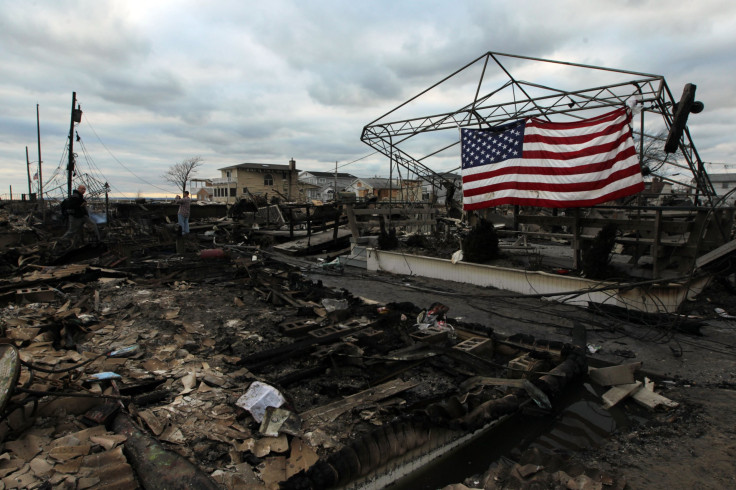Hurricane Joaquin 2015: How Much Do Major Storms Cost The US?

Hurricane Joaquin, a Category 4 storm with maximum sustained winds of 135 mph, continued to hurtle through the Bahamas on Thursday, CNN reported, and area residents were bracing for the expected destruction and dire economic aftermath of the storm. But as U.S. officials readied communities for a possible landfall in the days ahead, the storm was being seen as less likely to pose a major threat to the East Coast, the U.S. National Hurricane Center (NHC) said Thursday.
Although the NHC could not rule out a direct impact on the East Coast, it said in a storm update: "We are becoming optimistic that the Carolinas and the mid-Atlantic states will avoid the direct effects from Joaquin."
Nevertheless, governors of the Atlantic coastal states, with memories still fresh of the death and destruction wrought by Superstorm Sandy in October 2012, began preparing for the worst.
In the past, hurricanes have devastated the country economically. Hurricane Katrina in 2005 was the third strongest hurricane ever recorded to make landfall in the U.S. and was by far the costliest hurricane in the past 10 years for the U.S., resulting in roughly $108 billion in damage, according to the National Oceanic and Atmospheric Administration.
Nearly 200,000 homes were destroyed and 95 percent of oil production in the Gulf of Mexico region ceased when Katrina hit, ABC News reported. The storm forced the evacuation of more than 75 percent of the Gulf's 819 manned platforms, and overall, it affected 93,000 square miles across 138 parishes and counties, Fox News reported.
With Joaquin threatening the East Coast, the region might be flashing back to painful memories of Sandy. That storm slammed the area in 2012, wreaking major amounts of havoc. Sandy was the deadliest storm in the U.S. Northeast in 40 years and the second-costliest in the nation’s history, the Associated Press reported. Sandy reportedly caused an estimated $50 billion in damage: In all, more than 650,000 U.S. homes were damaged or destroyed by the storm, and more than 8 million customers lost electrical power.
Hurricane #Joaquin now an 'extremely dangerous' Category 4 storm, @NHC_Atlantic says https://t.co/UhImXWzgg1 pic.twitter.com/1P0S98O0xq
— NBC Nightly News (@NBCNightlyNews) October 1, 2015
Other massively destructive hurricanes to hit the U.S. include: Hurricane Ike in 2008 ($29.5 billion in damage); Hurricane Andrew in 1992 ($26.5 billion); and Hurricane Wilma in 2005 ($21 billion).
With such high costs, residents of the East Coast were bracing themselves for the worst because Joaquin could potentially be the biggest storm since Sandy to slam the region. Republican presidential candidate candidate and New Jersey Gov. Chris Christie declared a state of emergency Thursday morning and canceled all campaign appearances he had scheduled in New Hampshire until Tuesday, the New York Times reported. Governors in Virginia, Maryland, North Carolina and South Carolina have also declared a state of emergency and have directed agencies to prepare for flooding.
The National Weather Service predicted that as much as 10 inches of rain would fall in some areas, regardless of which path the hurricane ultimately takes. In Kitty Hawk, North Carolina, officials were hoping that sandbags might help protect the town if the hurricane ends up striking the Outer Banks, NBC News reported.
Emergency operation centers in New York were staffing up and government departments were to begin monitoring areas that have been prone to severe weather, New York Gov. Andrew Cuomo said.
"I have learned the hard way that it is better to prepare for the worst, and in the past, we were not. We did not take worst-case scenarios into full consideration and we paid the price," Cuomo said, NBC News reported.
© Copyright IBTimes 2024. All rights reserved.






















